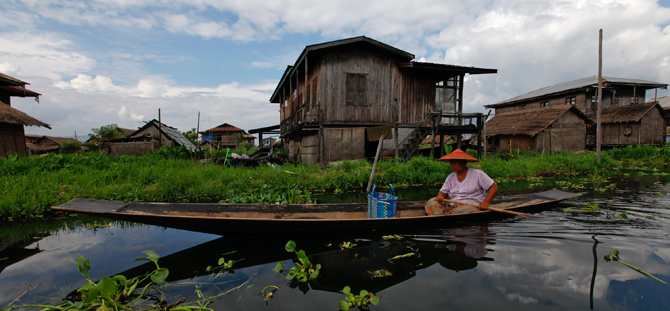Inle Lake Faces Serious Threat of Water Poisoning

Environmentalists claim that scenic Inle Lake, Burma's second largest inland body of water, needs urgent attention to prevent severe poisoning from pesticides and aggressive development.
“There have been reports of water poisoning in some areas. The water in certain areas is not clean enough to drink,” said U Ohn, general secretary of the Forest Resource Environment Development and Conservation Association.
He said that increased water pollution affects the health of those who live on the 116 kilometer-square lake situated up in the Shan Hills, and chemical poisons have been found in some fish and vegetables—especially the region's staple crop of tomatoes.
“The PH level in the central lake is around 9.6; 8.4 in Kaela to the west; 9.1 in Maing Thoak to the northeast; 8.9 in Nang Pan and 9.3 in Inn Paw Khon to the southern central area; and 9.0 in the area by the new Phaung Daw Oo Pagoda,” stated a report from the Burmese Fisheries Department, released in late February, which claimed that the breeding of local fish species had been affected.
U Ohn told The Irrawaddy that the use of chemical fertilizer and insecticide at the floating farms should be banned with biologically friendly alternatives used instead.
“The way of life and some traditions of the lake-dwellers must be changed. In some areas of the lake, they bury bodies in the water only covered with floating islets. This is not actually good for the well-being and I really don’t like this tradition,” he added.
Another factor is increasing waste discharged into the lake as the result of a high population and a rising number of tourists visiting the area. Waste from hotels has especially been causing much of the pollution, claim environmentalists.
“We need to educate the locals as well as businessmen to preserve nature and protect water purity in the region by not pumping waste into the water before it is too late,” said U Ohn. “Tourists also need to be aware of their responsibilities when visiting the area.”
He said some locals use distilled water as they fear drinking the dirty stuff straight from the lake, while others cannot find time and have no choice but to use the lake water.
In the summer of 2010, droughts across the country caused by high temperatures and late monsoon rains caused a severe drop in the water level of Inle Lake.
This summer as well, some areas of the lake are starting to decline slightly with locals and environmentalists fearful that the same problems will strike again.
According to experts, Inle Lake is one of the regions most at risk from climate change as well as deforestation of its surrounds.
“Preservation of the forest in the surrounding area is important. Although tourism to the region is beneficial for the economic development of local people, demarcating the hotel zone with limits on the number built is required to prevent pollution,” said Win Myo Thu of Economically Progressive Ecosystem Development.
“The pollution concentration will increase as the water level drops and will affect hundreds of thousands of habitats who need access to clean water,” he added. “Much more work and effort is needed to save this region, especially projects for clean water. However, the funding we have for these urgent projects is sadly much too little.”
Located in Taunggyi District of southern Shan State, Inle Lake is one of Burma's most picturesque places and a popular tourist attraction. It is famous for floating gardens and markets, the Phaundaw Oo pagoda and locals who build houses on the lake and row boats by wrapping one leg around an oar.
|
||
|
||
|
||
|
||
|
||
|
||
- 'My Wife Died From Police Abuse,' Says Husband
- US Says Observer Conditions Don't Meet Int'l Standards
- 159 Observers to Monitor Burma Election
- Govt to Address Breaches of SSA-South Ceasefire: Aung Min
- Burma Investors Pin Hopes on Seminal Sunday
- Malaysia PM Leads 50-Strong Delegation to Burma
- US Congress to Assess Burma's Political Prisoner Issue
- Rangoon Woman in Police Station Death Plunge
- Burmese Legal System Remains Tool of Govt: AHRC
- Burmese Army Chief Defends Political Role
